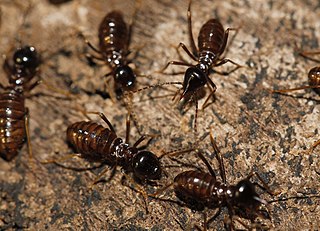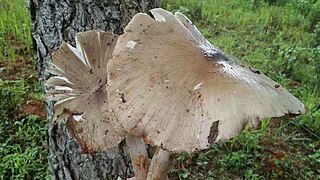The Low-country tea termite,, also known as Low country live wood termite, is a species of damp wood termite of the genus Glyptotermes. It is endemic to high elevations Sri Lanka. It is a major pest of tea in low country area of Sri Lanka.
The domestic drywood termite,, is a species of dry wood termite of the genus Cryptotermes. It is native to Malaysia, Borneo, Australia, China and Sri Lanka. It is mainly a house termite and also found in cultivated areas. The presence of this termite can be identified by small heaps of tiny egg-like pellets of excreta. It is a larger termite species, with 3.25-5.90mm in soldiers. It is considered as a minor pest in Australia, but is a serious pest causing wood damage in other parts of the world.
Heterotermes indicola, is a species of subterranean termite of the genus Heterotermes. It is native to tropical India, Pakistan and Sri Lanka but has extended its range into the subtropics and warm temperate areas of the Himalayan foothills to altitudes of about 2,000 m (6,600 ft). It causes damage to timber in buildings and is one of the most destructive termites in urban and agricultural areas in the world. Soldiers are about 4.1-4.9mm long. Extracts of garlic and Calotropis procera are known to have termiticidal effects on H. indicola.
Macrotermes convulsionarius is a species of termite of the family Termitidae. It is native to India and Sri Lanka. Soldiers are very large with well developed mandibles. It is a major pest of many wood works in buildings. Flagellated bacteria such as Bacillus, Acinitobacter, Salmonella, Enterobacter, and Enterococcus are found abundant in gut of M. convulsionarius.
Odontotermes ceylonicus, is a species of termite of the genus Odontotermes. It is native to India and Sri Lanka. Though nests in the ground, they never construct termitaria. It attacks many dead, diseased rotten plant roots and wooden buildings. It is a major pest of sugarcane and a secondary pest of tea.
Odontotermes escherichi, is a small species of termite of the genus Odontotermes. It is native to India, Sri Lanka and Peninsular Malaysia. It attacks many dead, tree stems and decaying logs.
The Fungus-growing termite,, also known as South Asian wood-destroying termite, is a small species of earth dwelling termite of the genus Odontotermes. It is native to India and Sri Lanka.
Odontotermes globicola is a species of small termite of the genus Odontotermes. It is native to India, Malaysia and Sri Lanka. It is found under flower pots and decaying logs. They construct small chambered nest with spherical combed termitaria.

Odontotermes horni, is a species of termite of the genus Odontotermes. It is native to India and Sri Lanka. It attacks many dead, decaying trees and fertilized soil. Though nests on ground, they do not construct a termitaria. It is a pest of tea, coconut and sugarcane.
Odontotermes koenigi, is a species of termite of the genus Odontotermes. It is native to India and Sri Lanka. It is a pest of tea.
Odontotermes preliminaris, is a species of termite of the genus Odontotermes. It is native to India and Sri Lanka..
Odontotermes redemanni, is a species of termite of the genus Odontotermes. It is native to India and Sri Lanka. It damages wooden constructions. It is a pest of sugarcane, tea and coconut. They construct termitaria during November to March when rainfall and ambient temperature become low. Underground termite nests of this species are a natural host for the important Traditional Chinese Medicine fungus Xylaria nigripes, also known as Wu Ling Shen.
Microtermes obesi is a small species of termite of the genus Microtermes. It is native to India, Sri Lanka, Pakistan and Vietnam. It is a major pest of wheat and minor pest of sugarcane.
Microtermes macronotus is a small species of termite of the family Termitidae. It is native to India and Sri Lanka.
Ceylonitermes escherichi is a species of termite. It is endemic to Sri Lanka.

Hospitalitermes monoceros, is a species of nasute termite of the genus Hospitalitermes. It was originally considered to be endemic to Sri Lanka, but was also found in India in 2013. It is an obligate lichen feeder. It is recorded from Cassia multijuga and Ficus religiosa trees and is a pest of tea.
The snouted harvester termite is a species of mound building termite in the genus Trinervitermes, native to India and Sri Lanka. The type species was described from the Bandarawela area of Sri Lanka. It is a pest of sugarcane and brinjal.

Odontotermes, commonly known as the fungus-growing termites, is a termite genus belonging to family Termitidae, which is native to the Old World. They are most destructive in wooden homes, and are agricultural pests in the tropics and subtropics of Africa and Asia. It is the most diverse termite genus in Africa, with 78 species recorded.

Odontotermes obesus is a species of termite in the family Termitidae. It is native to tropical southwestern Asia. This termite cultivates a symbiotic fungus in a special chamber in the nest. Workers gather vegetable detritus which they bring back to the colony, chewing up the material to make a suitable substrate on which the fungus will grow.


